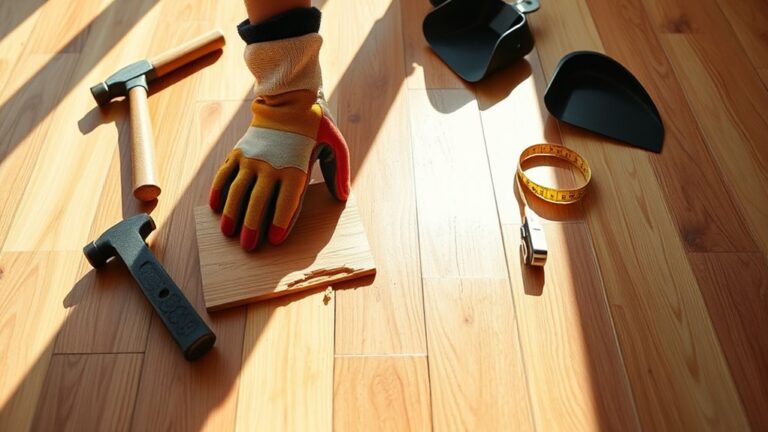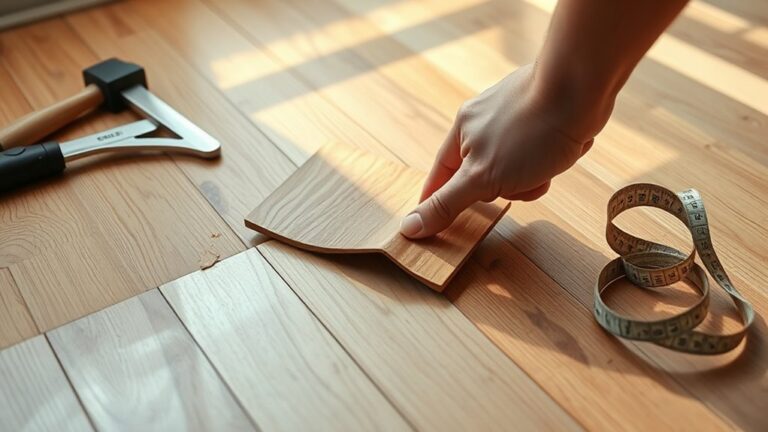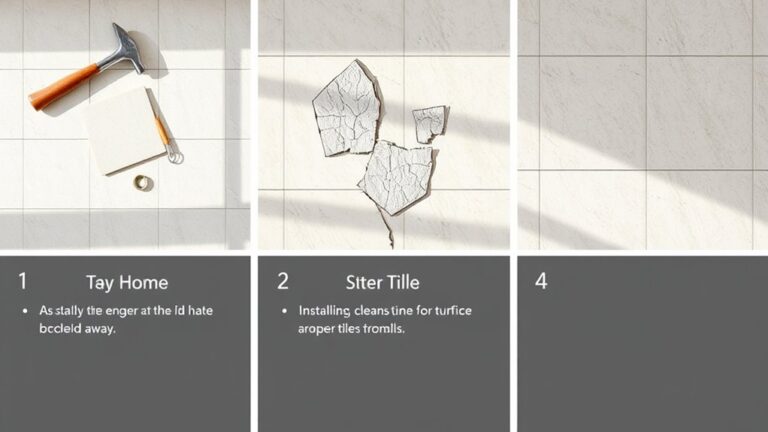When installing laminate in your bathroom, start by prepping the space. Remove existing flooring and make certain the subfloor is clean and dry. Acclimate your laminate planks for 48-72 hours to prevent expansion issues. Use a moisture-resistant underlayment and create a vapor barrier over concrete subfloors for extra protection. Don't forget to seal edges and joints with waterproof silicone caulk to block water intrusion. Regularly monitor humidity levels to guarantee ideal conditions. Finally, act quickly to clean up spills and maintain your laminate's integrity over time. There's much more to discover about maintaining and enhancing your bathroom's flooring!
Benefits of Laminate Flooring
When you're considering flooring options, laminate offers a compelling blend of style and practicality. With its realistic visuals and textures, laminate closely resembles real wood, elevating the aesthetic appeal of your bathroom. This means you can achieve that luxurious look without breaking the bank.
One of the standout features of laminate flooring is its water resistance. Bathrooms are often humid spaces prone to moisture exposure, but laminate stands up to the challenge, making it a smart choice for your DIY project. You won't have to worry about warping or damage like you might with traditional hardwood.
Installing laminate is a breeze. If you're up for a weekend DIY project, you can transform your space without hiring professionals. The easy installation process allows you to save both time and money, giving you the freedom to personalize your bathroom however you like. Plus, laminate's protective top layer resists wear and tear, so maintaining its fresh appearance is simple and hassle-free.
Affordability is another major benefit. Compared to traditional hardwood options, laminate flooring provides a budget-friendly alternative that doesn't compromise on style. So, if you're looking for a flooring solution that combines beauty, durability, and ease of installation, laminate is the way to go. You'll enjoy a stunning bathroom that reflects your personal taste while keeping your wallet happy.
Ideal Bathroom Sizes
Choosing the right bathroom size for laminate flooring can greatly impact its performance and longevity. If you're planning to install laminate, consider opting for smaller spaces like half baths or master suites. These areas typically have lower humidity levels due to the absence of tubs or showers, which minimizes water damage risks considerably.
Here are some key points to keep in mind:
- Lower Humidity: Smaller bathrooms tend to retain less moisture, making them ideal for laminate.
- Easier Maintenance: Compact spaces are often maintained more diligently, reducing the chances of warping or mold growth.
- Less Water Exposure: Half baths usually don't experience the same levels of water exposure as larger bathrooms.
- Quick Drying: Limited space means faster drying times for spills, which helps protect your laminate.
- Durability Focus: The size directly influences the laminate's durability, so smaller is often better.
Importance of Waterproof Caulk
When installing laminate flooring, using waterproof silicone caulk is essential for preventing water intrusion that could lead to long-term damage. It guarantees a durable seal around edges and fixtures, adapting to temperature changes without cracking. Plus, applying it correctly not only protects your investment but also keeps your warranty intact.
Preventing Water Intrusion
To guarantee your laminate flooring stands the test of time, preventing water intrusion is essential. Using waterproof silicone caulk during installation is a vital step you shouldn't overlook. Unlike standard grout, silicone caulk remains flexible and impenetrable, effectively sealing gaps that could allow moisture to seep beneath the laminate.
Make sure to apply caulk around edges, particularly near sinks and toilets, to greatly reduce the risk of water damage. Neglecting to use waterproof caulk may void your laminate's warranty and lead to costly repairs.
Here are some practical tips to enhance moisture protection:
- Choose high-quality waterproof silicone caulk for best results.
- Apply caulk evenly and thoroughly around all fixtures.
- Regularly inspect caulked areas for signs of wear or deterioration.
- Consult with retailers or contractors for best practices.
- Don't wait for visible damage; maintain your caulk proactively.
Ensuring Long-Term Durability
Applying waterproof silicone caulk is just the beginning of guaranteeing your laminate flooring lasts. This essential step fills gaps and allows for necessary expansion and contraction, keeping your flooring intact. Unlike standard grout, silicone caulk is flexible and impervious to moisture, offering superior protection against water damage. If you skip this critical application, you risk voiding warranties, which could lead to costly repairs from moisture-related issues.
To maximize the longevity of your laminate flooring, it's imperative to install waterproof silicone caulk around all edges and seams, especially in moisture-prone areas like bathrooms. Properly sealing these areas prevents moisture from seeping underneath, which can cause mold growth and warping over time. Consult both your retailer and contractor to guarantee you're applying the caulk correctly.
Proper Application Techniques
Properly applying waterproof silicone caulk is essential for achieving a durable laminate flooring installation. This step is often overlooked, yet it plays a pivotal role in preventing moisture infiltration that can compromise your flooring over time. Silicone caulk is flexible and impenetrable, providing superior protection compared to standard grout. By taking the time to apply it correctly, you're guaranteeing your laminate lasts longer.
Here are some key points to take into account when using waterproof silicone caulk:
- Seal edges and joints: Fill any gaps around the laminate's edges and between joints.
- Choose the right caulk: Consult retailers for the appropriate type of silicone for your specific laminate.
- Prepare surfaces properly: Clean the area before applying caulk to guarantee a strong bond.
- Apply evenly: Use a caulking gun for a smooth, consistent application.
- Allow for curing time: Let the caulk cure fully before exposing it to moisture.
Failure to follow these proper application techniques may not only void your warranty but can also lead to significant water damage. Invest this time now, and enjoy the freedom of worry-free laminate flooring in your bathroom!
Edge Protection Techniques
When installing laminate flooring, guaranteeing effective edge protection is essential to maintaining its longevity and appearance. In moisture-prone areas like bathrooms, edge protection techniques can greatly reduce the risk of water damage. One of the most effective methods is to install decorative tile borders around key wet areas, such as bathtubs, showers, sinks, and toilets. These tiles not only enhance the room's aesthetic but also create a barrier that prevents water from seeping beneath the laminate edges.
Another important step is utilizing waterproof silicone caulk. This product fills any gaps at the edges of your laminate flooring, allowing for natural expansion and contraction without compromising the integrity of the flooring. Properly sealing these ends is critical—after all, inadequate sealing could lead to warranty voiding due to water damage.
Don't forget to regularly inspect and maintain these edge protection areas. By doing so, you can catch any potential issues before they escalate into long-term problems like mold growth, warping, or further water damage. It's all about taking proactive steps to guarantee your laminate flooring remains in top condition.
Managing Humidity Levels
While edge protection techniques are essential for safeguarding your laminate flooring, managing humidity levels is equally important. High humidity can lead to significant wear and tear on your flooring, making it vital to maintain a balanced environment. To help you protect your investment, here are some practical tips:
- Run exhaust fans during and after showers to effectively reduce humidity and moisture levels.
- Open windows whenever possible to promote ventilation and air circulation, helping keep humidity levels in check.
- Regularly monitor humidity levels, aiming to maintain them between 30-50% for ideal laminate preservation.
- Consider a dehumidifier if humidity levels frequently exceed recommended ranges, adding an extra layer of protection.
- Wipe up standing water immediately to prevent moisture from seeping between laminate seams, which can lead to mold growth and damage.
Preventing Water Damage
Water damage is a major concern for laminate flooring, and taking proactive steps can save you from costly repairs down the line. To keep your laminate looking great and functioning well, it's essential to manage any water exposure effectively. First and foremost, always wipe up any standing water immediately. This prevents moisture from seeping between the seams, which can lead to mold growth and warping.
Regularly inspect your bathroom for leaks or sources of moisture. These can greatly contribute to water damage, so identifying them early can save you headaches later. Another smart strategy is to use rugs in high-moisture areas, like around sinks and bathtubs. These rugs not only absorb excess water but also provide a slip-resistant surface.
When choosing laminate flooring, look for options with a high moisture resistance rating. For areas with frequent water exposure, consider 100% waterproof vinyl as an alternative. This can provide peace of mind without the risks associated with traditional laminate.
Installation Steps and Tips
Installing laminate flooring can be a straightforward process if you follow the right steps. First, you'll want to remove any existing fixtures and flooring. Make certain your subfloor is clean, level, and dry to prevent future issues. Next, acclimate your laminate planks in the bathroom for 48-72 hours. This helps minimize the risk of expansion or contraction caused by humidity.
Here are some tips to guarantee a smooth installation:
- Use a moisture-resistant underlayment to protect against water damage.
- Create a vapor barrier over concrete subfloors for extra protection.
- Cut precisely around toilets and drains with a jigsaw and paper templates to maintain proper expansion gaps.
- Leave an expansion gap between boards to allow for natural movement.
- Seal edges with waterproof silicone caulk after installation to prevent water seepage.
Once you've laid the underlayment and started to install your laminate, you'll find it's easy to install. Just make sure you keep that gap between boards for expansion and contraction. After finishing, don't skip the caulk—it's essential for long-term durability in a bathroom setting. With these steps, you'll enjoy a beautiful, functional laminate floor that can withstand the humid environment of your bathroom. So go ahead, embrace your freedom to create a space you love!
Frequently Asked Questions
What Are Some Common Mistakes When Laying Laminate Flooring?
When laying laminate flooring, it's easy to make common mistakes. For one, not leaving proper expansion gaps can lead to buckling or warping. Also, skipping the underlayment choice can expose your floors to water damage and increase noise levels. Remember to acclimate your planks before installation, and always double-check your measurements to avoid misalignment. Taking these steps guarantees your laminate flooring looks great and lasts longer. You're creating a beautiful space—don't rush it!
What Direction Should Laminate Flooring Be Installed in a Bathroom?
Installing laminate flooring in a bathroom is like painting a masterpiece; the right direction makes all the difference. You'll want to contemplate the installation orientation carefully, ideally aligning it with the main light source for the best visual effect. Guarantee proper subfloor preparation for moisture resistance, and remember to keep expansion gaps around the edges. This'll not only enhance the look but also help your flooring withstand the bathroom's unique conditions.
Is It Okay to Put Laminate Flooring in a Bathroom?
Yes, it's okay to put laminate flooring in a bathroom, but you need to guarantee it has laminate moisture resistance. You might also want to explore bathroom flooring alternatives if you're concerned about water exposure. To keep your laminate in top shape, remember these laminate maintenance tips: clean up spills immediately and use waterproof silicone caulk around edges. With the right precautions, you can enjoy the aesthetic appeal of laminate in your bathroom.
Do You Have to Remove a Toilet to Install Laminate Flooring?
Installing laminate flooring is like piecing together a puzzle; each piece needs to fit just right. You don't have to remove the toilet, but doing so can simplify the process. Toilet removal provides better access and guarantees your flooring underlayment fits snugly. Keep plumbing considerations in mind if you choose to leave it in place, as cutting around the base can be tricky. Proper sealing will help prevent moisture issues, so plan accordingly.




